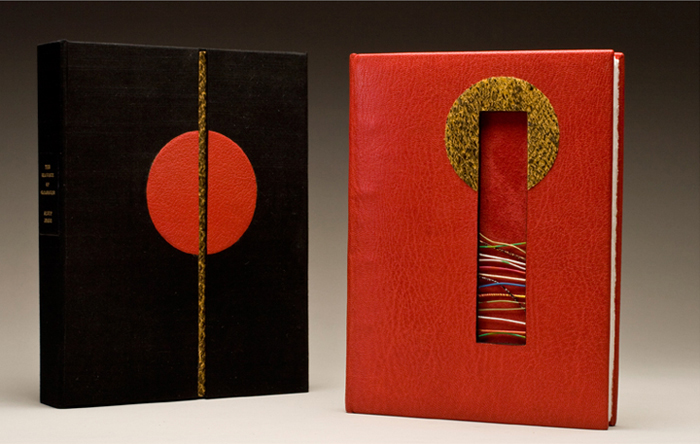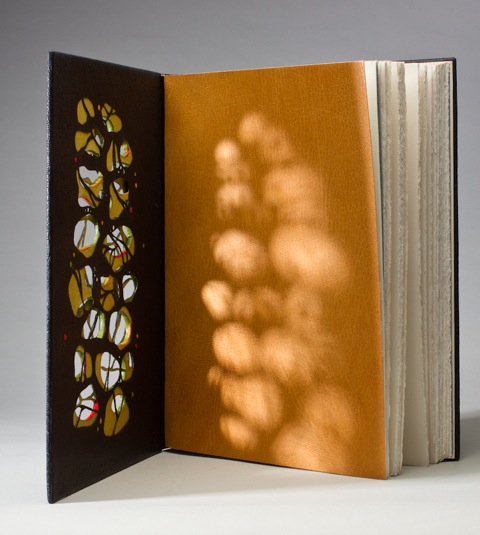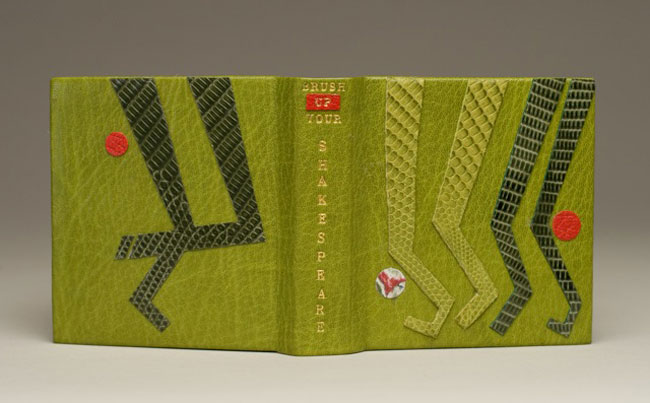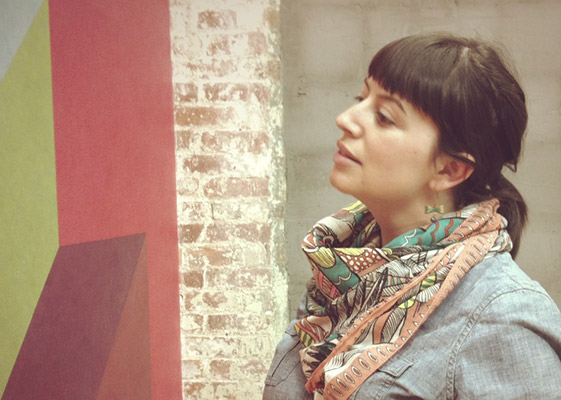This stunning binding was created by Monique Lallier almost ten years ago. Yet the design appears so fresh and relevant to the experimentations happening with contemporary design bindings. When you land on Monique’s website, this is the binding you are greeted with and it will, no doubt, cause you to click through every single page of the gallery. The Drawings of Caravaggio by Ally Jones was bound in full scarlet leather in the French technique. The boards have been cut to reveal the red suede fly leaves through a collection of wires that have been embedded into the thickness of the board. Straddled around the top edge of the cut-out is an onlay of snakeskin.
The book is housed in a box covered in black silk with matching red and snakeskin onlays.
If I remember correctly you told me that this is one of the first bindings you completed and that it is still your favorite. I love this binding as well for many reasons: the use of bright colors, contrasting textures from the goatskin, suede flyleaves and snakeskin onlay and the inclusion of a window cut-out of the cover. This window element is peppered throughout your portfolio. What does this element bring to your designs and why do you keep coming back to it?
This binding was done in 2005. I had done the “window element” before to give space for an agate in 1985, so I suppose it evolved to an opening that was not totally filled-in like The Fables of Aesop where I have wires imbedded in the thickness of the front board and you see, through the opening to the lion stamped on the leather fly leave, or this Caravaggio, also with wires imbedded in the thickness of the boards. It was done in an advanced class for AAB (American Academy of Bookbinding) and I wanted to show the students how to line the thickness of the boards with black leather in this case.
I suppose I keep coming back to it because I like the effect of “seeing through”, like in Les Sonnets (shown below) where the boards, the covering leather and the leather doublures are all cut out. In this case, it was to illustrate how Les Sonnets have an impression on you. (More images on this binding later!)
Monique’s work is awe-inspiring. Not only do I find her bindings to be so, but also her involvement in the bookbinding community. Our community and the craft of bookbinding thrives when talented and dedicated people like Monique become teachers. Between my first and second year at North Bennet Street School, I jumped at the opportunity to take a week-long private workshop with Monique at her home in North Carolina, where I absorbed everything she had to offer (no doubt an infinitesimal amount to the vast knowledge she holds).
I’m really honored that Monique agreed to be interviewed for my blog, which she has complimented me about several times. So without furthering gushing, please enjoy the interview after the jump. Stay updated with posts by signing up for an email subscription. Since Monique has an ample collection of work, each week I’ll be showcasing multiple bindings including a few newly bound and unseen works!
Having over 4 decades worth of experience, how have your seen the bookbinding industry evolve?
The industry has evolved rather slowly. The techniques, English, French or German have changed very little in the last three centuries and are based on a great understanding of the mechanisms of the book. However, the scene of design binding as evolved and book arts exhibitions have sculptural books and everything other than design bindings as we know them. It keeps the interest in books alive, but I wish design binding exhibitions to be more frequent and better covered by the media.
Are you at all concerned with its future or do you see enough interest both in new generations of bookbinders and the pubic?
There will always be beautiful books, well printed and well illustrated, an art piece in itself. The same way the photograph didn’t “kill” painting, e-books won’t have an impact on limited edition books. They are two different breeds.
Jumping back to the beginning, was there a pivotal moment that directed you from the path to becoming a geography teacher into a career as a bookbinder?
I have always loved books. Books were my companion as for the first 9 years of my life I was an only child. We had a library at home and it was my preferred room in the house.
So because I had my afternoon free, as I was teaching in a high school with two schedule, I was looking for something to do in the afternoon. There was an article about Simone B. Roy as she was opening her studio in the Old Montreal. I called her and went for my first class the very next day. I was hooked, everything pleased me, the old tools, the leather, the handmade papers and the decorative ones, everything. I knew then that it was what I wanted to do for the rest of my life.
In a past interview, you name your first teacher Simone B. Roy and later Hugo Peller as being your most influential teachers. Are you incorporating their techniques and insights as you teach?
Simone and Hugo were very influential and I still use many techniques that I have learned from them and teach them to my students. Of course we evolve and there is some things that I have changed, as I am sure Simone has changed some things since she taught me in the early 70s. For example, I use a hollow tube for a better opening and I don’t line the spine with 6 layers of Arches paper like I use to do. My boards are much thinner then when I first started….
Today, I think there are many bookbinders that would consider you influential to their role as a bookbinder. In fact, your name has appeared in several of the interviews I’ve conducted. So many bookbinders, including myself, have crossed paths with you through various study opportunities. I very much admire the way you teach, you are very firm and precise and yet your disposition is warm and encouraging. Has teaching always come naturally to you? When did you first begin teaching bookbinding?
I love teaching. I love feeling the enthusiasm about bookbinding in young people. I started teaching bookbinding when Simone asked me to take the responsibility of the teaching at L’Art de la Reliure (the name of her studio). I continued teaching when we opened our own Atelier: Les Relieurs Artisans on Laurier St. I have been teaching ever since. I studied education at the University of Quebec at Montreal and at the University of Montreal after I realized my love for teaching when I was asked by my mother to teach sewing to the ladies of her church group. I then decided to go back to school after having my two sons….
One aspect of your teaching that I find admirable is your own desire to learn. In our profession, I think there is always room to grow no matter how long you’ve been a binder. Which is why I really enjoy the Standards of Excellence Conference hosted by the Guild of Book Workers. You’ve been a member for about as long as you’ve been binding and you’ve presented twice (in 1990 and 2002). Can you talk about your involvement with the Guild and how you’ve seen it evolve?
The Standards of Excellence of GBW was started by Don Etherington in 1980 to show bookbinders the highest quality of work. There was 4 presenters, like today, and the audience was no more than 25 per group, for a more intimate session and to encourage questions. Each presenter has to do his presentation 4 times, which was rather tiring. When I was Chair of the Standards of Excellence we tried to accommodate more people so we added a fifth presenter and each participant had to choose 4 presentations. Each group could take 35 people so we were having 140-145 participants. Still, the presenters has to do it 4 times.
With the last Standards in Washington, DC the format was changed and everybody was in the same room with four big screens….everybody loved it and we hope that it will be the way we go in the future.
What other organizations are you affiliated with?
I like to encourage the bookbinding organizations so I belong to many of them, in Quebec: AQRAL, in Canada: CBBAG and ARA, in England: Designer Bookbinders and The Society of Bookbinders, in France: ARA etc……
Today you reside in North Carolina, but your training and career in bookbinding began in Montreal. How does the community surrounding bookbinding differ from Canada to here in America? Was it difficult for you to find clients after moving to America?
When I first move to North Carolina, I had customers in Quebec that were still sending me work but it became more difficult because of the custom fees. It took a while to have customers in the US. I participated in as many exhibitions as I could and collectors started to notice my work and give me commissions.
Are you solely a fine and design binder or are you producing other types of work for clients?
I can produce other type of work, like my pewter photo albums or other type of photo albums, simple bindings in leather or paper. If a client has a special request I try to honor it and not every book deserve a full scale design binding. I have done cross structure, two boards structure, sewn boards structure and I consider them fine bindings.
I first came across your work in my first year studying bookbinding at North Bennet Street School. I was instantly pulled into the bold designs that evoke a high level of confidence and artistic skill. When you approach a fine binding, what is your creative process like?
Oh! the creative process….it can be painful, it can be fun, it can be slow and it can be quick. The first thing I do is leafing through the book to look at the illustrations and typography, then, I read it and take notes. Most of the time I have images and colors and style of design, i.e. bold shape or delicate lines, straight lines or curvy ones…all this, “dance” in my head, I let it “marinate”. Then images started to come up and it very often happened around 5 am, before I really wake-up….
I am glad that you see confidence in my designs because I am very critical of my work.
Do clients want to be apart of this creative process?
Very rarely do clients want to be part of the process, they have seen my work and they like it, so they want me to be free to express myself on their binding. Sometime a client will ask for a sketch before I proceed, but I tell them that I want to be free to let the design evolve as I work on the binding.
Your portfolio also includes a collection of miniature work. How did you get into miniature bindings? Was this something you experimented with on your own or did you receive formal instruction?
I love miniature books. They are challenging and that what makes them interesting. My first attempt was a book 1” by ½”. A book about “women’s thoughts”. So when I showed it to Don, my English husband, he quipped: Oh! That’s why it’s so small!!! Typically British! I have done many miniatures since then and the main challenge is in the proportion of the design and….your fingers feel very big!
In preparation for this interview I reread the interview you did with Pamela Train Leutz in her book The Thread That Binds. Towards the end of the interview you mention that you would like to write a technical book about bookbinding. The American Academy of Bookbinding recently launched Imagine a Beautiful Book, which includes a history of the school, the state of the art studio renovations and a side-by-side binding comparison between yourself and Don Glaister. In addition to this publication, do you still have plans to publish your own technical bookbinding guide?
Some days I want to, some other days I think that there are very good books out there and I am not sure what else I would bring that makes it worldwide. So for now, we should keep it quiet.




[…] Read more about Monique in this recent interview by Herringbone Bindery. […]
Hi,I am a amateur bookbinder,and I just found your amazing blog today. I am so excited to see these interviews with bookbinders I admire for a long time.And I want to say thank you for sharing these really really good interviews with us:))) huhu
Welcome to the blog. I’m so glad to hear your excitement. I hope you find inspiration in my posts.